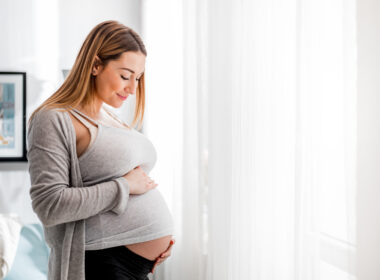Cesarean births, commonly referred to as C-sections, comprise about 1 of every 3 births in the United States, and 4 out of 5 mothers who have had one Cesarean will have a repeat C-section(s) [1]. While C-sections have become normalized in today’s society, the reality is that a Cesarean es a major abdominal surgery replete with the potential for complications that can occur both during and after surgery. Rates of C-sections are especially high in overweight and obese women due to medical comorbidities such as heart disease, high blood pressure, and diabetes. With the obesity epidemic on the rise alongside the increase in C-section rates, researchers at the University of Oklahoma sought a way to protect pregnant women from unneeded invasive surgery. Specifically, they explored whether giving antibiotics during labor induction reduced C-section risk in women with obesity.
Pregnant women with obesity are at risk for many pregnancy complications
Pregnant women with obesity can experience a host of serious medical complications including “miscarriage, gestational diabetes, preeclampsia, venous thromboembolism, induced labour, caesarean section, anaesthetic complications and wound infections” and endometritis [2][3]. In particular, women with obesity who have their labor inducido are at higher risk of developing infection, be it chorioamnionitis, endometritis, or C-section wound infection [4].
Because of the risks obese women face in pregnancy, birth, and postpartum, finding a way to decrease the likelihood of these infections as well as decreasing the rate of C-section delivery is an important step in ensuring the health of mothers and babies. According to the Clínica Mayo, C-sections in themselves can lead to a whole host of health complications including breathing problems or surgical injury to the baby, as well as infection, blood loss, blood clots, surgical injury to the bladder or bowel, and negative reactions to anesthesia in the mother.
Both obesity and labor cause inflammation in the body, and inflammation can lead to infection
Obesity is characterized by chronic inflammation, and labor is also characterized by inflammation [5]. Too much inflammation (not just from a specific “bug” or type of bacteria) in a pregnant woman’s body can lead to spontaneous development of chorioamnionitis [6]. One estudiar published in American Journal of Obstetrics and Gynecology showed that 75% of mothers with spontaneous chorioamnionitis during labor experienced decreased uterine contractions, and 34% required a C-section due to labor failing to progress [7].
Researchers at the University of Oklahoma School of Medicine theorized that giving antibiotics during labor induction might prevent an infection severe enough to necessitate a C-section for delivery. While administering antibiotics before surgery–including C-section–is common practice, researchers had never before studied whether starting antibiotics at the onset of labor would lead to lower levels of infection, and consequently, lower rates of Cesarean delivery.
Could antibiotics reduce C-section rates in first time mothers with obesity?
The University of Oklahoma College of Medicine trial study was published in 2022 in the American Journal of Obstetrics and Gynecology MFM (Maternal-Fetal Medicine) [8]. The lead researcher was Stephanie Pierce, M.D., an OU Health maternal-fetal medicine specialist and associate professor in the OU College of Medicine. She tested whether administering antibiotics to obese women undergoing inducción del parto would decrease the likelihood of needing to perform a C-section.
Pierce declaró:
“Today, 40% of American women are obese when they become pregnant, and they [typically] have health problems that make them more likely to require [induced] delivery before their due date, typically at 39 weeks. Sometimes, a C-section is necessary, but it can cause other problems, such as wound infections and a higher risk of bleeding. Because labor inductions have increased along with the rise in obesity, we need a way to minimize C-sections so the mother can have the lowest risk for complications. We are conducting this study with first-time mothers with obesity because they have the highest risk for a C-section.”
Pierce is correct. Approximately 40% of women in America are obese, measured by a BMI (body mass index) of 30 kg/m2 or greater. BMI is a measurement calculated by dividing a person’s weight by their height squared, and while there are outliers in the reliability of relating BMI to health or fat-mass, for the average person, they are relatively strongly correlated.
OU researchers separated participants into categories by weight
The study took 186 women that were at least 37 weeks pregnant with a planned induced labor of their first child at 39 weeks gestation. Researchers separated women by obesity class to determine whether antibiotics impacted them differently. 101 women had Class I obesity (BMI 30-34.9), 47 women had Class II obesity (BMI 35-39.9), and 38 women had Class III obesity (BMI 40+). All women were pregnant with only one baby, were free of any infections requiring antibiotics antes de the induction of labor, and all the babies were in good health.
Women in each of the three tested BMI Classes were divided into two groups—one receiving both 2g of the antibiotic cefazolin at the start of labor induction (and every 8 hours for a total of 3 doses), as well as 500mg of the antibiotic azithromycin at the start of labor, with the other group receiving a saline solution placebo at the same intervals.The two groups of women were randomly selected in a “triple-blind” trial where the investigators, medical staff, y patients were all unaware of the treatment group the women were in. Aside from the administration of the antibiotic or placebo, all women received the standard labor, delivery, and postpartum care as any other obstetrics patient at that hospital, including management of any other health conditions.
Measuring rates of C-section delivery and postpartum infection in women who did or didn’t receive antibiotics
The two primary outcomes studied were rates of delivery via C-section, and rates of postpartum infection within the first 30 days after birth (specifically chorioamnionitis, endometritis, and/or Cesarean wound infection). The secondary outcomes studied were rates of postpartum hemorrhage, blood transfusion, ICU admission, or maternal or infant hospital admission after delivery.
Here’s what the OU researchers learned
While infection rates were not markedly different between women who did and didn’t receive antibiotics, those who received antibiotics at the outset of labor had a 27% lower rate of C-sections.
While infection rates were not markedly different between women who did and didn’t receive antibiotics, those who received antibiotics at the outset of labor had a 27% lower rate of C-sections.
It’s complicated to calculate exact numbers, but let’s make some approximations in order to contextualize how much difference antibiotics at the start of labor might make for women with obesity. In 2020, there were 3,605,621 births in the United States, according to the Centros para el Control y la Prevención de Enfermedades (CDC). 31.8%, or 1,146,587 were Cesarean deliveries. If 40% of all pregnant women had obesity, that would represent 458,635 of the women who had C-sections. And if the 27% reduction observed in the trial study from administering antibiotics to women at the start of labor applied to all (not just first-time) laboring women with obesity, there would have been 123,831 menos C-sections that year.
An additional surprising finding in the trial was that there was a superior chance of sepsis in the babies whose mothers received antibiotics throughout labor. Researchers want to study this outcome more thoroughly in future studies in order to find out why that unexpected correlation was noticed.
How might the OU research impact maternal health practices?
Because of the marked rate of C-section reduction in this small trial study, combined with the relatively low cost and easy access to antibiotics, the National Institutes of Health (NIH) awarded the University of Oklahoma team a $3.1 million grant to expand their study to several hospitals across the country. Working together under Dr. Pierce’s guidance, Duke University, University of Alabama at Birmingham, University of Florida, and Case Western University in Cleveland’s MetroHealth Medical Center hospitals will enroll around 800 mothers with obesity in the next five years.
“This is an exciting opportunity to develop a new intervention that can improve outcomes for pregnant women with obesity,” Pierce dijo. “The issue of obesity has been challenging to obstetricians, and the average BMI during pregnancy is only increasing. It is very gratifying to be part of a team that is developing a solution that has the potential to decrease complications and improve the health of mother and baby alike.”
This article was updated on March 26th, 2025, to correct the BMI Class weight ranges included in the 2022 University of Oklahoma study.
Referencias:
[1] Osterman MJK. Changes in primary and repeat cesarean delivery: United States, 2016–2021. Vital Statistics Rapid Release; no 21. Hyattsville, MD: National Center for Health Statistics. July 2022. DOI: https://dx.doi.org/10.15620/ cdc:117432. [2] Fitzsimons KJ, Modder J, Greer IA. Obesity in pregnancy: risks and management. Obstet Med. 2009 Jun;2(2):52-62. doi: 10.1258/om.2009.090009. Epub 2009 May 22. PMID: 27582812; PMCID: PMC4989730. [3] Axelsson, D., Brynhildsen, J., & Blomberg, M. (2023). Maternal obesity and the risk of postpartum infections according to mode of delivery. The Journal of Maternal-Fetal & Neonatal Medicine, 36(2). https://doi.org/10.1080/14767058.2023.2245102 [4] Weiss JL, Malone FD, Emig D, Ball RH, Nyberg DA, Comstock CH, Saade G, Eddleman K, Carter SM, Craigo SD, Carr SR, D’Alton ME; FASTER Research Consortium. Obesity, obstetric complications and cesarean delivery rate–a population-based screening study. Am J Obstet Gynecol. 2004 Apr;190(4):1091-7. doi: 10.1016/j.ajog.2003.09.058. PMID: 15118648. [5] Chandrashekara Kyathanahalli, Madeline Snedden, Emmet Hirsch, Is human labor at term an inflammatory condition?, Biología de la reproducción, Volume 108, Issue 1, January 2023, Pages 23–40, https://doi.org/10.1093/biolre/ioac182 [6] Jain VG, Willis KA, Jobe A, Ambalavanan N. Chorioamnionitis and neonatal outcomes. Pediatr Res. 2022 Jan;91(2):289-296. doi: 10.1038/s41390-021-01633-0. Epub 2021 Jul 1. PMID: 34211129; PMCID: PMC8720117. [7] Duff, Patrick, et al. “The Course of Labor in Term Patients with Chorioamnionitis.” American Journal of Obstetrics and Gynecology, Mosby, 21 Dec. 2016, www.sciencedirect.com/science/article/abs/pii/S0002937816322311.
[8] Pierce SL, Peck JD, Zornes C, Standerfer E, Edwards RK. Antibiotic Prophylaxis to Prevent Obesity-Related Induction Complications in Nulliparae at Term: a pilot randomized controlled trial. Am J Obstet Gynecol MFM. 2022 Sep;4(5):100681. doi: 10.1016/j.ajogmf.2022.100681. Epub 2022 Jun 18. PMID: 35728781; PMCID: PMC9611553.








Have you considered the detriment of antibiotics on the immune system of both the mother and baby? C-section does have risks. Obesity has risks. Antibiotics do too! Why not encourage obese mothers to look into truly natural measures for helping prevent c-sections. Your whole premise for not using birth control is that it alters the body’s functions in a longterm and often a forever way, often causing horrible side effects that are a struggle to recover from…why would you promote another type of prescription that does the same thing!? I was damaged by the antibiotics given to me (not obese) for GBS and have not recovered my pre-birth health since that incident. What about the evidence-based studies that discuss how the antibiotics given to the mother enter the baby and make them resistant to that type of antibiotic if it’s needed in case of emergency? or the damage to the mother and baby’s microbiome? Some bacterias killed by antibiotics can never be replaced – to start off a child’s life by wiping out what is not beneficial for their immunity or childhood health. The more antibiotics a person has in their lifetime, the risk increases for antibiotic resistance. You raise the risk also of candida when you wipe out the microbiome in mom and raise the risk of thrush in the breast and transfer it to baby which can be a huge stress. This can lower the desire to breastfeed and often cause mom and baby to be prescribed antifungals. This is another cause for a cascade of interventions that are costly and make people turn back to the pharma world rather than avoiding it to begin with. What are the options for natural birth for obese women outside of antibiotics and c-sections? How can they naturally reduce inflammation if it is present because of their obesity? Making healthy diet choices and gentle exercise. Not feeding inflammation and infection through sugar and foods with unhealthy fats. Seeing what herbs and minerals are beneficial to lowering inflammation. Are there low risk homeopathic medicines available to help with both inflammation and healthy birthing? (Yes) Learning about birthing positions that are condusive to mothers with obesity – hint, hint not flat on the back. Most women, obese or not need gravity to assist birth. Seeking out a good health professional who isn’t going to do what’s easy for you or them in the moment but give you educated decisions about how their “intervention” may help you today but may cause side effects afterward. You have to know each medical procedure and prescription may have lasting results that move into your future – you can’t be truly informed if you don’t ask questions and get well-rounded answers. We have to think bigger and broader than using antibiotics for reducing inflammation no matter how and what studied have been done. Do your research!! I sure wish I had.
Hi Erica!
Thanks for your thoughtful comment. We applaud and share your commitment to helping other women make informed choices about their healthcare. It’s true that antibiotics kill good bacteria along with the bad and can therefore disrupt the gut microbiome. It’s also true that there are many ways to reduce a pregnant woman with obesity’s likelihood of having a C-section.
Our readers, presumably, are all over the map in terms of health and wellness and their willingness to embrace and pursue natural options. Avoiding a C-section for a woman with obesity is a great start and even if she has zero support from a midwife or other ways to promote her giving birth vaginally, we would like her (and the healthcare professionals caring for her) to know about this option.